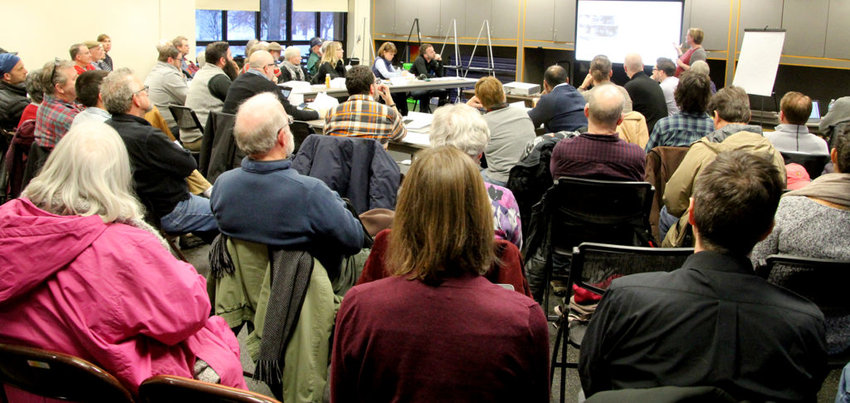 About 75 people attended the March 7 meeting to hear about, and offer input, on three possible options for the Hiawatha Golf Course property. (Photo by Tesha M. Christensen)
About 75 people attended the March 7 meeting to hear about, and offer input, on three possible options for the Hiawatha Golf Course property. (Photo by Tesha M. Christensen)
The community is considering the pros and cons of three designs for the Hiawatha Golf Course.
Designers expect to take components of the three options that were presented at a Community Advisory Committee (CAC) meeting on March 7 and fashion them into a preferred draft by late April/early May.
“Nothing here today is set in stone and cannot be changed moving forward,” Andy Mitton of Berger Partnership told the 75 people present at Powderhorn Park Recreation Center.
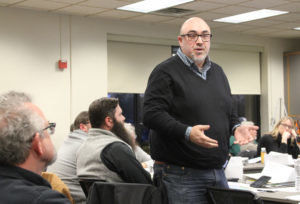 Photo left: CAC Chair David Kaplan stands up to ask attendees to hold their comments until the comment period at the end of the meeting after some started yelling because they were unhappy the first option presented did not include at least nine holes of golf. “I’m trying to move us forward. Yelling at me and your neighbors is not very helpful,” stated Kaplan during the March 7 meeting at Powderhorn Park. (Photo by Tesha M. Christensen)
Photo left: CAC Chair David Kaplan stands up to ask attendees to hold their comments until the comment period at the end of the meeting after some started yelling because they were unhappy the first option presented did not include at least nine holes of golf. “I’m trying to move us forward. Yelling at me and your neighbors is not very helpful,” stated Kaplan during the March 7 meeting at Powderhorn Park. (Photo by Tesha M. Christensen)
About the three options
Mitton explained that they first looked at the water footprint and elevation of the site, and then fashioned various uses around that information.
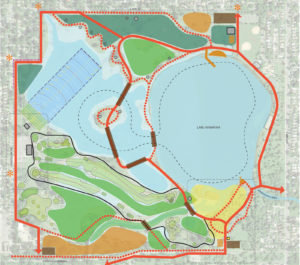 Option 1, titled “Expanding Opportunities” (illustration right provided), would remove the existing berm next to Lake Hiawatha and allow the water to equalize. This plan includes many other options but only four practice holes, golf skills development area, and aqua range.
Option 1, titled “Expanding Opportunities” (illustration right provided), would remove the existing berm next to Lake Hiawatha and allow the water to equalize. This plan includes many other options but only four practice holes, golf skills development area, and aqua range.
By doing that, designers made space for a BMX/pump track, aerial adventure course, disc golf, and pickleball court, as well as a new trailhead restroom/concession building, trails, discovery nodes, boardwalks, and bridges. There would also be space for hammocks (requested via an online comment) and possible adventure play such as hillside slides.
At the Native American focus group session held in November, designers were encouraged to incorporate native tree species such as cedar, cottonwood, ash, and white pine.
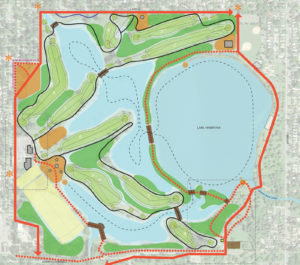 Option 2, titled “Experience Lake Hiawatha” (illustration left provided), includes a nine-hole golf course par 36 that ranges from easy to challenging and offers several beautiful vista points throughout the course. The water and golf footprint intermingle together, explained Mitton, and is done in a way that helps flood waters recede quicker than in the past.
Option 2, titled “Experience Lake Hiawatha” (illustration left provided), includes a nine-hole golf course par 36 that ranges from easy to challenging and offers several beautiful vista points throughout the course. The water and golf footprint intermingle together, explained Mitton, and is done in a way that helps flood waters recede quicker than in the past.
This plan includes a water access area with boat storage and rentals, along with a play area and viewing tower. Option 2 also includes an amphitheater where movies could be shown on an inflatable screen and an ethnobotanical garden.
An expanded clubhouse could include a golf learning center with new technology.
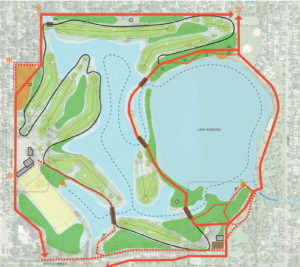 Option 3, titled “Back to Nature” (illustration right provided), also has a nine-hole course and expanded clubhouse, this time with a pro-shop, learning center with new technology and food service. It shifts the putting green around and includes a three-tiered driving range.
Option 3, titled “Back to Nature” (illustration right provided), also has a nine-hole course and expanded clubhouse, this time with a pro-shop, learning center with new technology and food service. It shifts the putting green around and includes a three-tiered driving range.
An ice climbing wall could be placed on one side of the two-story high clubhouse set into the hill.
In the southeast side of the land would be a parking lot and learning center with catering kitchen, the sort where canning classes could be held, observed Mitton.
The working vision statement for the committee is: “A unique destination providing a welcoming and equitable park experience for both the surrounding community and regional park users that is ecologically-responsible, addresses water management needs, and respectful of the site’s natural and cultural history. Park development will have a long-term focus for year-round passive and active recreation, where golf and other recreation will interface with ecology and art to provide for a flood-resilient design that is accessible, connected, and celebrates the spirit of Minneapolis.”
What’s the same
All three options reduce groundwater pumping at the site by 70%, as directed by the Minneapolis Park and Recreation Board of Commissioners. They also mitigate trash at the site by diverting the northwest storm sewer pipe. Two of them involve re-meandering Minnehaha Creek.
Mitton stressed that all three options include some type of groundwater pumping to protect area houses.
However, more drainage would be achieved via gravity pipes instead of through pumping.
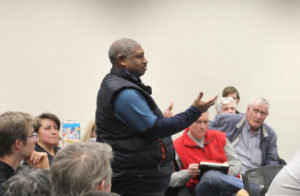 Photo left: Photo left: Bobby Warfield speaks during the March 7 Hiawatha Golf Course Community Advisory Committee meeting at Powderhorn Park. Three options for the golf course were presented at the meeting, and residents were encouraged to share their input with the Minneapolis Parks and Recreation Board. (Photo by Tesha M. Christensen)
Photo left: Photo left: Bobby Warfield speaks during the March 7 Hiawatha Golf Course Community Advisory Committee meeting at Powderhorn Park. Three options for the golf course were presented at the meeting, and residents were encouraged to share their input with the Minneapolis Parks and Recreation Board. (Photo by Tesha M. Christensen)
Designers hope to use pumped water as a resource by using it to irrigate the course (15-20 million gallons per year), make snow for a cross country ski loop (3.5-5 MGY), and heating and cooling an expanded clubhouse (4-8 MGY cooling, 4-19 MGY heating).
None of the options change the overall floodplain storage at the site, assured designers.
Knowing that the site may flood again simply due to its elevation, designers purposefully placed critical golf features on higher ground above the average water level of Lake Hiawatha so that they aren’t wrecked as they have been in the past.
How much will it cost?
MPRB Project Manager Tyler Pederson explained that the park would be funded as others are, through a combination of state and regional funds. Parks aren’t expected to generate all of their own revenue, although money could be earned at this site through concession sales, facility rentals, boat rentals, and golfing. The estimated revenue that could be generated at an updated golf course range from $700,000 to $1.3 million, depending on what is included in the plan.
The cost of construction ranges from $28.2 to $62 million, or $4-9 a square foot.
The annual maintenance cost is estimated to range from $1.1 to $1.5 million.
What people think
Some committee members, including Teresa Engstrom and Kathryn Kelly, were upset that none of the options included an 18-hole golf course.
Others stated their concern about putting too much in the southeast corner and interfering with the natural area there used by wildlife.
CAC member Tim Clemens supported planting indigenous species in the park that would complement art by indigenous artists.
Understanding how the water flows in the larger area around Lakes Hiawatha and Nokomis and Minnehaha Creek remains a priority for CAC member Joan Soholt, who garnered a round of applause after her call for a detailed study of the entire area. Senator Patricia Torres-Ray informed attendees of her intent to have a Senate hearing on surface water in this area.
“The reality is that we’re here because there are a number of things that are inviting us to look at change,” stated CAC member Roxanne Stuhr. “I think it’s tremendous that we’ve got this point, and I also think there is a lot of work to be done.”
She added, “We need to partner with nature.”
District 5 MPRB Commissioner Steffanie Musich thanked people for attending the meeting. Afterward she commented, “The world we are living in now is not the world our kids will be living in. We as a society need to find a way to adapt our landscapes to the changing reality—or nature will do it for us.”
Additional focus sessions were held on March 18 and 19 to gather input on golf, African American golfers, environmental factors, neighbors, and
Indigenous and Dakota, mirroring a similar set of focus groups in November 2018.
The committee is expected to finalize a design by June, and hold a public hearing in September.
Comments
No comments on this item Please log in to comment by clicking here